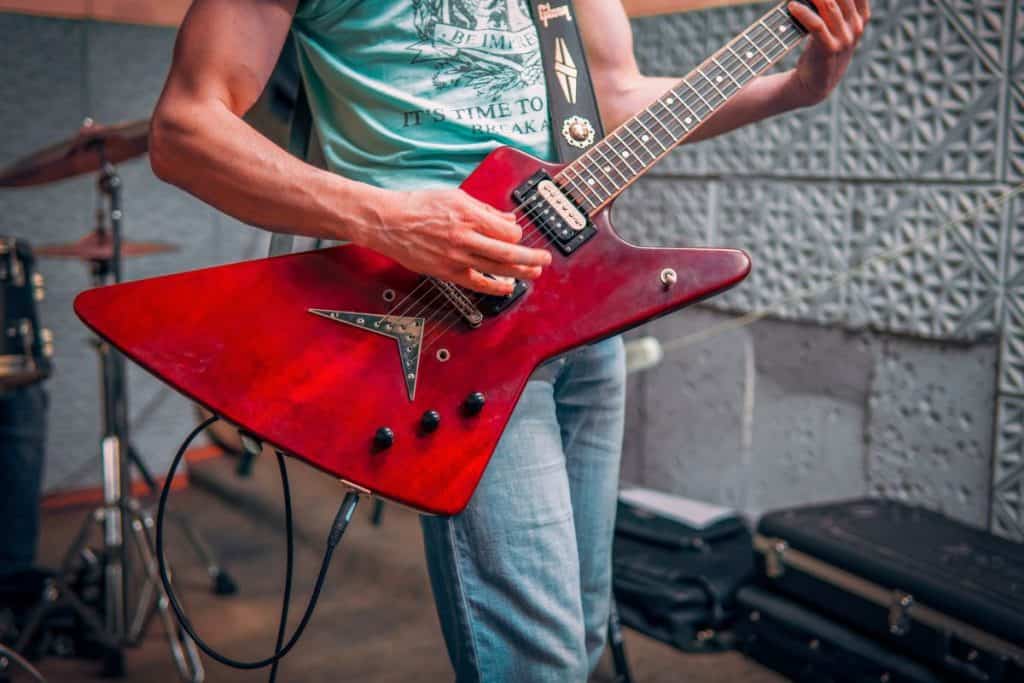The guitar is probably one of the most practiced instruments on the planet.
No country has managed to escape the catchy claws of this impeccable musical tool of so many musicians, and there probably isn’t a song or genre on Earth that isn’t improved at least a little by the inclusion of a guitar.

Rock? It’s right at home there. A Jazz band? Not unheard of. A guitar in a classical orchestra?
Okay, that might be a little more unorthodox. But even then, electric guitars in symphony orchestras aren’t unheard of!
That might be part of the reason why guitars are as successful as they are.
Their versatility means that, with a little patience, trial & error, and creativity, they can fit just about any style or sound a band is going for.
But before all that creative possibility, a guitar has to be set up in the first place. And this is where the problems and frustrations can start.
To get your electric guitar fined tuned and ready to roll with, there is a pretty long and complicated set of steps that you’ll need to take to get your musical instrument just right.
The procedure itself isn’t difficult, necessarily. But it does take a little time, a little know-how, and a lot of patience to get it just right.
But once you do, you’ll have something that is tuned almost to perfection, so it is well worth it in the end.
That’s where this guide comes in.
We’ve compiled a list of some of the tools that you’ll need to fine-tune your electric guitar setup, as well as the steps you’ll need to take to get your setup just right for you.
Why Setting Up Your Guitar Is Necessary
Some people reading this guide may be wondering why you even need to set up a guitar like this in the first place. After all, isn’t it possible to buy a guitar already set up when you buy it?
To that question, we say that, whilst that is possible if you know where to get your guitars from, that isn’t always the case, or even possible.
If you hear someone asking this question when you start discussing setting up your electric guitar, there’s a decent chance that they simply haven’t bought an electric guitar online, or have only bought them from a guitar dealer.
Guitar manufacturers tend not to set up their guitars when they are delivered to you from an online store, meaning that the task of actually getting them playable falls on you.
If you are purchasing your guitar from a dealer or dedicated music shop, then it is certainly possible to buy a guitar that is already well set up for you or to pay the dealer to have it set up for you when you do buy it.
However, this can also cost you a decent amount of money, depending on the prices of your guitar dealership.
This isn’t always necessarily a bad decision to make, especially if you have the money to do so and very little spare time to set up your electric guitar yourself.
But if you do have the time, and you already have many of the tools needed, why not try it out for yourself?
Tools You’ll Need
These are the tools that will be vital for carrying out this procedure:
- A set of Allen keys of various sizes.
- Various screwdriver sizes, both Flat and Philips’s head.
- A chromatic tuner
Setting Up Your Guitar

Remove The Guitar’s Strings
The first step that you will need to take is to remove the strings from your guitar. You will be able to add new ones or simply reattach the current ones once you are done with the rest of the steps.
This can be a tricky step, given how much tension a guitar string is kept under.
If you want to avoid damaging the neck of your guitar, you should start by removing the two most outer strings (the two E strings), then working inwards from there with the next two strings (A and B), then removing the D and G strings in the center.
Clean The Fretboard
This step can be done with either a simple lacquer and damp cloth, or lemon oil/cleaning product, depending on the type of wood.
Replace Your Guitar Strings
If you want to get the most intonation out of your guitar, you should replace your old strings altogether.
When buying new guitar strings, make sure to get strings between 0.9 to 0.11 on the string gauge.
Test How Straight Your Guitar Neck Is
To do this, make sure your guitar is tuned right, then look down from the head to the body at both the treble and bass sides of the guitar.
Ideally, there should be no bowing, and the neck should be almost straight, with only a slightly concave shape.
Adjust Your Truss Rod
A truss rod is a metal beam that goes in your guitar’s neck and can be used to adjust how much your guitar’s neck curves. This is also a great way to get rid of fret buzz, so it’s useful to know about.
The truss road can be turned with an Allen key to either relieve more tension (counter-clockwise) or tighten it up (clockwise).
Set Your String Action
Make sure that your guitar strings have enough clearance from the frets, to avoid fret buzz. This can be done by adjusting the bolts at the guitar’s bridge.
Set Your Intonation
For this final step, simply tune your guitar with your chromatic tuner by pressing plucking a string unfretted, then when holding the twelfth fret.
If the tuner shows an E at both pluck, you’re good to go!
Final Thoughts
So, there you have it! Whilst setting up your guitar can seem intimidating at first, once the process is broken down for you, you’ll be surprised how easy it can be!
